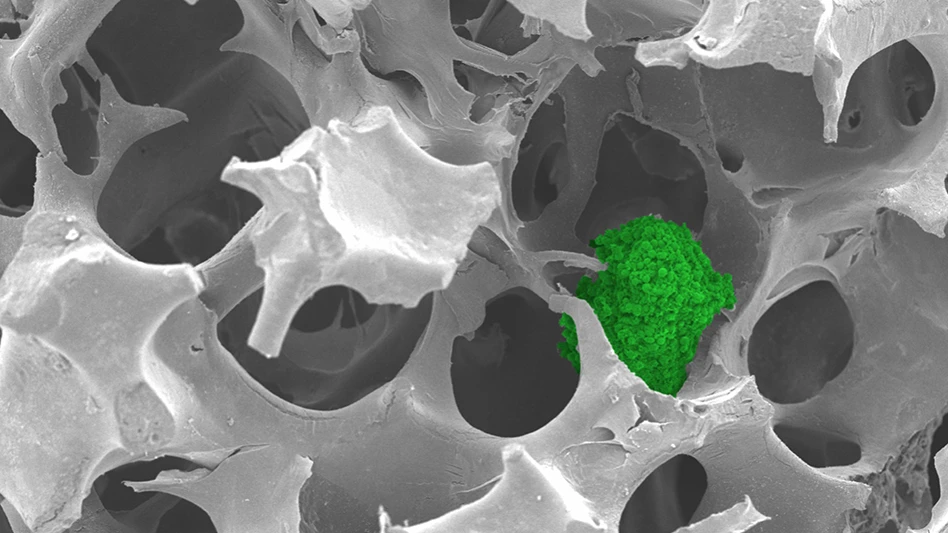
Image courtesy of Nanyang Technological University
Motivated by a global plastic recycling rate of around 10 percent, researchers at Nanyang Technological University (NTU) in Singapore have been developing ways to convert discarded plastic into scaffolding for tumors cultivated for laboratory testing purposes.
The project is one of three at NTU that have been designed to divert plastic scrap streams, including obsolete electronics and marine sector discards using new methods.
The laboratory tumors scaffolding application involves acrylonitrile butadiene styrene (ABS) commonly used in computer equipment. The NTU researchers say they have developed a synthetic matrix for culture cells using ABS from discarded keyboards.
“The matrix is porous like a sponge and functions as a support structure, providing a framework for cells to attach and grow,” the university says.
The matrix can host spherical clusters of cells, called cancer spheroids, that resemble actual tumors more accurately than many existing cell cultures.
“The matrix supported the growth of breast, colorectal and bone cancer spheroids [that] had properties similar to those grown using commercially available matrices and may be used for biomedical applications such as drug testing,” NTU says.
The research findings were reported in the “Resources, Conservation & Recycling” ScienceDirect publication earlier this year.
“Our innovation not only offers a practical means to reuse e-waste plastics but could also reduce the use of new plastics in the biomedical industry,” says Associate Professor Dalton Tay of NTU’s School of Materials Science and Engineering, who led the research.
Another NTU project involved converting marine plastic litter into hydrogen and carbon additives for polymer foams.
The researchers used high temperatures and the absence of oxygen to break down the molecules into solid carbon and hydrogen. The solid carbon can be added to polymer foam to increase its strength and resistance to abrasion for cushioning applications, according to NTU, and the hydrogen produced can be collected and used as fuel.
“We have developed a feasible approach to repurpose hard-to-recycle plastics, which is an important aspect of the circular economy,” says lead investigator Associate Professor Grzegorz Lisak of NTU’s School of Civil and Environmental Engineering.
A summary of the project has been published in the Journal of Hazardous Materials, which also is a ScienceDirect publication.
In the third NTU project, researchers say they developed a process to convert a wide range of plastics, including polypropylene (PP), polyethylene (PE) and polystyrene (PS), into chemical compounds that can be useful for energy storage.
“The reaction uses light-emitting diodes (LEDs) and a commercially available catalyst and occurs at room temperature," NTU says. "Compared to conventional plastic recycling methods, the process requires much less energy.”
The plastic scrap is first exposed to a solvent, and the resulting solution is mixed with the catalyst and directed through transparent tubes, where LED light shines on it.
The resulting end products are compounds such as formic acid and benzoic acid, which can be used to make other chemicals employed in fuel cells, and liquid organic hydrogen carriers (LOHCs), which NTU says are being explored by the energy sector as a storage media for hydrogen.
According to Associate Professor Han Soo Sen of NTU’s School of Chemistry, Chemical Engineering and Biotechnology, who led the study, the breakthrough provides a potential end market for plastic scrap while also reusing the carbon trapped in these plastics instead of releasing it into the atmosphere as greenhouse gases through incineration.
Findings from this NTU research project were published last year in the journal Chem, which is part of Cambridge, Massachusetts-based Cell Press.
Get curated news on YOUR industry.
Enter your email to receive our newsletters.
Latest from Recycling Today
- Republic Services, Blue Polymers open Indianapolis recycling complex
- Altilium produces EV battery cells using recycled materials
- Brightmark enters subsidiaries of Indiana recycling facility into Chapter 11
- Freepoint Eco-Systems receives $50M loan for plastics recycling facility
- PET thermoform recycling the focus of new NAPCOR white paper
- Steel Dynamics cites favorable conditions in Q1
- Hydro starts up construction in Spain
- Green Cubes unveils forklift battery line





